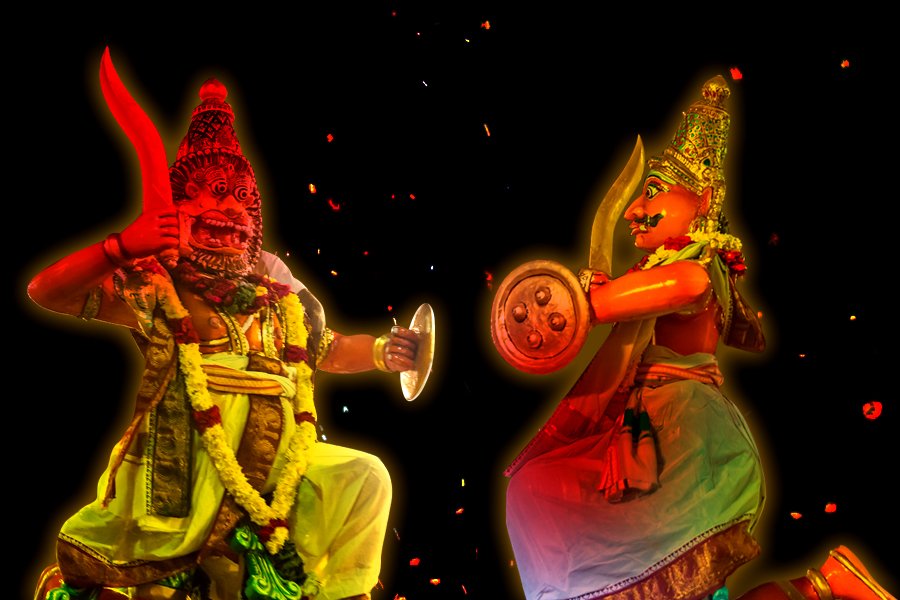Read in : தமிழ்
In Tamil Nadu, the word Sooran has an interesting connotation. The word rhymes with Veeran, the brave, but Sooran is not just brave but also skilled, talented and brainy. Tamil Wiktionary says Sooran excels in the intellect. Sooran can also refer to a dog, a lion, a cock, a bear, fire and the sun.
Soon after Deepavali, a period of fasting begins in the state. Called Sashti Viradam, this is celebrated as a festival in Murugan temples. The festival culminates in a Soora Samharam, or Sooran Paadu, as villagers say, which is a show and an enactment.
Among the places where Sooran Play is grand and remarkable is the temple in Kazhugumalai, Tirunelveli. As the festival begins, evenings turn colourful. Many types of Soorans, massive wooden dolls, are brought in a procession near the temple as if the dolls have been endowed with life.
Soorans take various forms: the elephant face, the green face, the midget and the toothy smile. The elephant-faced Sooran is decked in black and the toothy smile in yellow. The last one to come, Kadaikutti, is in white.
The Sooran dolls are made with much care. Artistes work with carved wood and adorn the figures with bright cloth. Mud pots are used, too. Natural colours are splashed. The workplace where these dolls are made often looks like a big workshop.
Men get into the Sooran dolls and walk along a preset route, in a dance. The doll is made like a wooden cage. The doll is hollow at its lower part and is square shaped. On the day of the Sooran Padu, the chosen man enters the doll from below. The Sooran artiste takes a deep breath and holds the doll to carry it.
Physical strength is required. A special diet is followed. The Sooran men need to take care of their health so their bodies are strong enough for the play.
Not just the bodies, but the mind needs to be strong, too. Prep work includes longer meditations. The mind and the body are prepared for the Sooran Padu. A period of time is set aside for the prep work so the mind and the body integrate, unite.

Soorasamharam in Tiruchendur
The artiste holding the Sooran can go short of breath. To help in their breathing, airways are made in the wooden framework. Arrangements are also made to hold the Sooran dolls easily.
As two people tilt the Sooran, the artiste wiggles into it. He holds the Sooran as others let go of the doll. After balancing himself based on the weight of the doll, the artiste starts swaying.
As he starts swaying rapidly, the artiste has to be doubly careful. He should never lose self-awareness. If he drops the doll, it would lead to much heartburn and approbation. It would be taken as a bad omen.
It would be a disaster if the artiste trips and the Sooran doll falls on the ground. Life would not be the same. The incident would remain in the minds and tongues of village folk. Any unfortunate happening would be linked to it.
The Sooran artiste therefore has much responsibility on his shoulders, and his hands. People’s faith and confidence in their future are at stake.
During the Sooran Padu, the artiste disappears. His body vanishes and his thoughts, too. Just the faith and the energy of the doll manifests. In the emerging darkness of the night, amidst the crowd, people see only the swaying, dancing Sooran doll gliding along. For children, it’s a sight of wonder. They hoot with joy.
During the time of the festival, the Sooran comes dancing each day. Which Sooran comes on which day is a guessing game for the children that day. The toothy smile and the elephant-face are their favourites. Vallagai is a favourite of women.
The day before the Samharam, the last day, a mini Sooran’s head is smashed to destroy the doll. Women would brave the crowds and the sweat and hold their children on their shoulders so they could catch a glimpse of the sight.
Such colourful Sooran festivals were celebrated across Tamil Nadu. Today, rituals are dominating, however.
The festival may be traditional but it caters to current trends, thoughts, beliefs and requirements, too. The celebration has changed, too.
The festival is celebrated when the north-east monsoon sets. But the Sooran festival is not just about celebration. It reflects the season, too.
The way the festival ends is unique. I used to go to the Sooran festival at Thoppur Subramaniya Swamy in Marungur, Kanyakumari, in the 1970s. A small village of farmers, the place used to become the center of attraction.
As multicoloured insects flitted by, marking the onset of rains, the destruction of Sooran would be enacted during sunset. The Sooran doll would then be set on fire.
As if on cue, farm workers would grab the firewood and run into the fields. They would throw the firewood pieces on the insects.
I used to wonder what was the significance of this act. I concluded that it was probably just man’s misunderstanding of how nature works.
Farming follows seasons and climate. When rains come, the soil becomes fertile. Lifeforms sprout. Dragon-flies and other insects proliferate. Their impact is felt everywhere.
The ignorant human doesn’t understand that the insects proliferate to maintain balance in nature. He thinks the change will harm his life.
The Soora Samharam is probably a festival symbolizing the fight against insects. Today, the same fear has fed toxic pesticides being used to exterminate insects although people understand that insects can maintain balance in the environment.
Man has always thought of destroying lifeforms that come to restore balance. Today, it is the pesticide. In the past, it was colourful dance.
Today, pesticides have proliferated hospitals even as the colourful dance of the past persists as ritual and superstition. And the new age mind seeks solace in myths and lifeless imprints of the past.
Read in : தமிழ்











